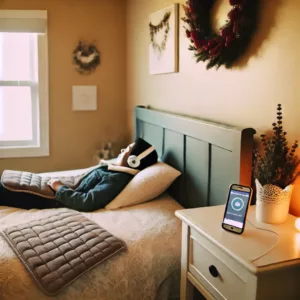The Holidays – Joyful or Overwhelming?
The holidays sparkle with joy, but for those managing chronic pain or illness, the glitter can sometimes feel like a weight. Studies reveal that over 70% of individuals with chronic conditions experience heightened symptoms during the festive season due to stress and overexertion. But what if the holidays could be both joyful and manageable?
With thoughtful pacing, proactive planning, and supportive strategies, you can create a season that prioritizes your well-being without sacrificing cherished moments
Consider creating a visual calendar that lets you see your commitments at a glance. Block off time for important traditions but leave enough gaps for rest. There’s power in seeing your plans laid out; it reminds you to be realistic about what you can handle.
Discuss your schedule with your close family and friends. Let them know what you’re up for and what might be too much. Most people want to help—you just need to let them know how. And remember, it’s okay to have days where you do absolutely nothing. Give yourself permission to rest. Prioritizing the right activities ensures you’ll have enough energy to be fully present during the ones you value most, making the holidays all the more special.
Why Pacing Matters During the Holidays
The holidays amplify everything—social gatherings, to-do lists, and expectations. For individuals with chronic pain or illness, this can lead to:
- Overexertion: Too many activities in a short span can trigger flare-ups or leave you drained.
- Stress and Anxiety: Rushing through the season’s demands can increase tension, worsening physical symptoms.
- Emotional Burnout: Overwhelming schedules often leave little room for self-care, leading to feelings of frustration or sadness.

Mindful pacing helps you balance celebration and rest, ensuring you can participate in meaningful traditions without sacrificing your health.
Prioritize What Matters Most
Why It’s Important:
Holidays are a time for connection, but when you’re managing chronic pain or illness, overextending yourself can lead to physical setbacks and emotional exhaustion. Prioritizing activities that align with your values and energy levels ensures you enjoy meaningful moments without unnecessary stress.
How to Do It:
- Reflect on Your Holiday Goals:
Ask yourself what truly brings you joy during the holidays. Is it family traditions, quiet moments, or certain social events? Focusing on these will help you eliminate unnecessary obligations.
Example: If decorating the house makes you happy, focus on a few favorite decorations instead of trying to transform every room. 
- Create a Priority List:
Divide your holiday tasks and events into three categories:- Essential (must-do): Activities that hold deep personal meaning, like a family dinner.
- Optional (nice-to-do): Events or tasks you enjoy but can skip if needed, like a work party.
- Unnecessary (can skip): Things you do out of habit or obligation, such as attending every neighborhood gathering.
- Visualize Your Schedule:
Use a physical or digital calendar to map out your commitments. This helps you see potential conflicts and ensures you schedule downtime. - Communicate Your Limits:
Let loved ones know what you can and can’t handle. Early communication prevents misunderstandings and helps others support you.
Supporting Data:
- The American Psychological Association (APA) highlights that managing stress during the holidays by prioritizing meaningful activities can significantly reduce physical and emotional strain.
Incorporate Rest Breaks and Recovery Time
Why It’s Important:
Rest isn’t a luxury—it’s a cornerstone of managing chronic pain and illness. Scheduled downtime helps your body recover, prevents flare-ups, and keeps your mind centered during the bustling holiday season.
How to Do It:
- Schedule Downtime:
Block out time on your calendar for recovery breaks. Treat these moments as non-negotiable appointments to rest or recharge.
Example: Plan a 20-minute power nap after lunch or a quiet hour with a book after a family gathering.
- Listen to Your Body:
Pay attention to warning signs like increased fatigue, muscle stiffness, or heightened pain. These are cues to slow down or stop for a moment.- Proactive Tip: Use a timer or set reminders on your phone to check in with yourself throughout the day.
- Incorporate Active Recovery:
Rest doesn’t have to mean inactivity. Gentle stretches, breathing exercises, or even a walk in a quiet, festive park can offer physical and mental rejuvenation. - Prepare Restful Spaces:
Designate a calming corner in your home or identify quiet spots at gatherings where you can step away when needed. This creates a go-to haven for moments when you need to decompress.
Supporting Data:
- The National Institute of Neurological Disorders and Stroke (NINDS) emphasizes that rest and recovery are essential for managing chronic conditions, reducing pain levels, and improving emotional resilience. Link to NINDS Chronic Pain Guidance
- A study published in the Pain Research and Management Journal revealed that individuals with chronic conditions who incorporate regular rest periods report fewer flare-ups and improved daily functionality. Link to Study
Simplify Holiday Traditions
Why It’s Important: Simplifying holiday activities reduces physical and emotional strain while preserving the festive spirit.
How to Do It:
- Shop Smart: Opt for online shopping to skip the crowds and save energy. Many retailers offer great deals and free shipping during the holidays.
- Focus on Meaningful Decor: Choose a few favorite decorations that bring joy without requiring hours of setup. Turn it into a fun, collaborative activity with loved ones.
- Host Low-Key Gatherings: Potlucks or casual get-togethers shift the workload and let you enjoy your guests without overexerting yourself.
By streamlining your holiday traditions, you can conserve energy for the moments that matter most, fostering connection and joy without the overwhelm.
Setting Boundaries on Spontaneous Events
Why It Matters:
The holidays often bring unexpected invitations or last-minute changes, which can throw off your carefully managed energy levels. Without boundaries, these situations can lead to overexertion and unnecessary stress. Setting clear boundaries empowers you to make thoughtful choices about where and how to participate.
How to Do It:
- Pause and Reflect: When an impromptu invite arises, give yourself permission to evaluate whether it aligns with your current energy and priorities:
-
- Will attending this event enhance my holiday experience or leave me drained?
- Can I realistically manage this without compromising my health?
- Decline Kindly but Firmly: Saying no can feel uncomfortable, but it doesn’t have to. Try responses like:
-
- “Thanks so much for thinking of me, but I’ll need to sit this one out.”
- “I’d love to join another time, but I’m taking today to recharge.”
- Set Flexible Terms: If you want to participate without overcommitting, suggest compromises:
-
- “I can stop by for a short visit but may need to leave early.”
- “Could we connect virtually instead? I’d really love to catch up.”
Real-Life Example:
Lisa loves her neighborhood’s annual caroling event but knows her chronic fatigue flares up in the cold. Instead of joining for the entire evening, she suggests meeting the group afterward for hot cocoa and conversation by the fire. Her friends appreciate her effort to connect and adjust their plans to accommodate her needs.
Why This Solves the Problem:
Setting boundaries ensures you protect your energy without sacrificing meaningful connections. By communicating your limits, you reduce the risk of overexertion while staying engaged in ways that align with your well-being.
Plan Ahead for Flare-Ups
Why It Matters:
Even the best-laid plans can be disrupted by unexpected flare-ups of pain or fatigue. Having a proactive plan in place helps reduce the anxiety of these moments and ensures you can manage symptoms effectively, whether at home, a gathering, or traveling.
How to Do It:
- Flexible Transportation Options:
-
- Drive yourself to gatherings to maintain control over your arrival and departure.
- Use a ride-share app or coordinate with someone who understands your needs in case driving isn’t feasible.
- Create a Quiet Escape Plan:
-
- Identify a calm spot at events where you can rest if needed.
- Communicate with the host beforehand to secure access to a guest room or quiet corner.
- Pack a Personalized Comfort Kit:
-
- Include essentials like a heating pad, essential oils, medication, and a blanket.
- Add soothing items like noise-canceling earbuds, a calming playlist, or a small journal.
- Designate a Support Partner:
-
- Recruit a trusted friend or family member to discreetly check in on you.
- Use a subtle signal—like a text message or gesture—to communicate when you need assistance.
- Recognize Early Warning Signs:
-
- Pay attention to cues like rising fatigue, muscle tension, or increased discomfort.
- Address these symptoms immediately by hydrating, resting, or using items from your comfort kit to prevent escalation.
Example in Action:
At a family dinner, you notice signs of a flare-up: rising fatigue and discomfort. Instead of trying to push through, you excuse yourself to a quiet guest room. Using your comfort kit, you take 20 minutes to rest, listen to a calming meditation, and apply a heating pad. Feeling more refreshed, you rejoin the celebration with renewed energy.
Why This Solves the Problem:
By planning ahead, you’re equipped to handle unexpected challenges without feeling trapped or overwhelmed. This approach enables you to enjoy events at your own pace, with confidence and peace of mind.
Final Thoughts: Mindful Holidays, Your Way
The holidays are a time for creating cherished memories, but they don’t have to come at the cost of your well-being. By embracing mindful pacing, planning ahead, and listening to your body’s needs, you can celebrate with intention and joy. Remember, the magic of the season lies in connection, not perfection. Celebrate on your terms, and let each moment reflect what truly matters most.
Share these strategies with loved ones, and let’s make this holiday season one of balance, health, and meaningful moments.
Looking Forward: What’s Next in the Holiday Survival Series?
This guide is just the beginning of your journey to creating a calmer, more joyful holiday season. The next articles in the Holiday Survival Series dive deeper into some of the most pressing challenges faced by those managing chronic pain and illness during this festive time. Here’s what you can expect:
- Coping with Isolation and Emotional Challenges During the Holidays
Discover practical emotional support strategies to combat loneliness and navigate the heightened emotions that often accompany this season. Learn how to stay connected with loved ones, even from afar, and build resilience during moments of vulnerability. - Mindfulness Tips for a Calmer, Happier Holiday Season
Master simple yet effective mindfulness techniques to stay grounded amidst the holiday rush. From breathing exercises to sensory grounding, this guide will help you reclaim your peace and fully embrace the joy of the season. - Travel Tips for a Stress-Free Holiday Season
Whether you’re traveling to visit family or taking a much-needed getaway, this article offers essential advice for managing comfort and minimizing stress during your holiday travels. From packing hacks to mobility-friendly tips, we’ve got you covered.
Stay tuned as we continue to explore strategies that empower you to enjoy the holidays on your terms. Don’t miss out on these valuable insights—bookmark this page and return for the full series. Together, we’ll make this season one to remember for all the right reasons!
PLEASE JOIN OUR COMMUNITY!




